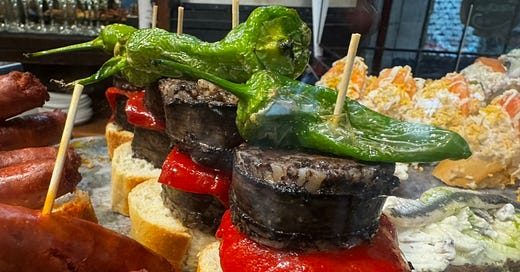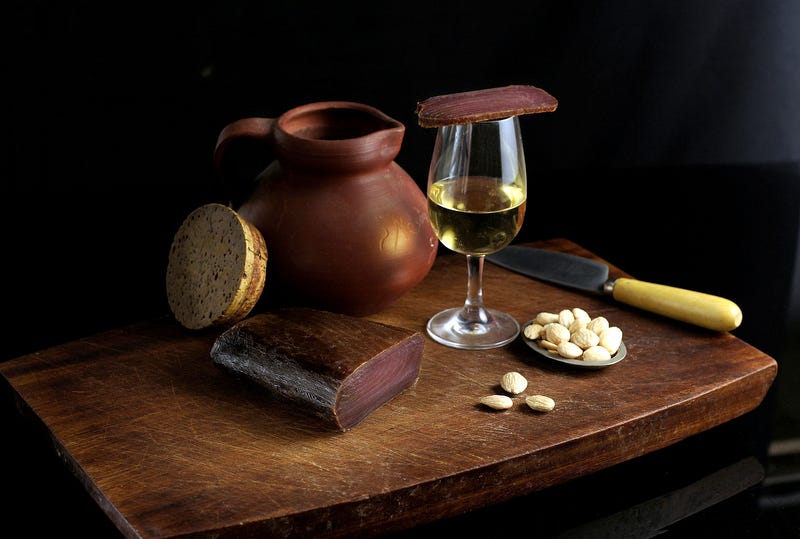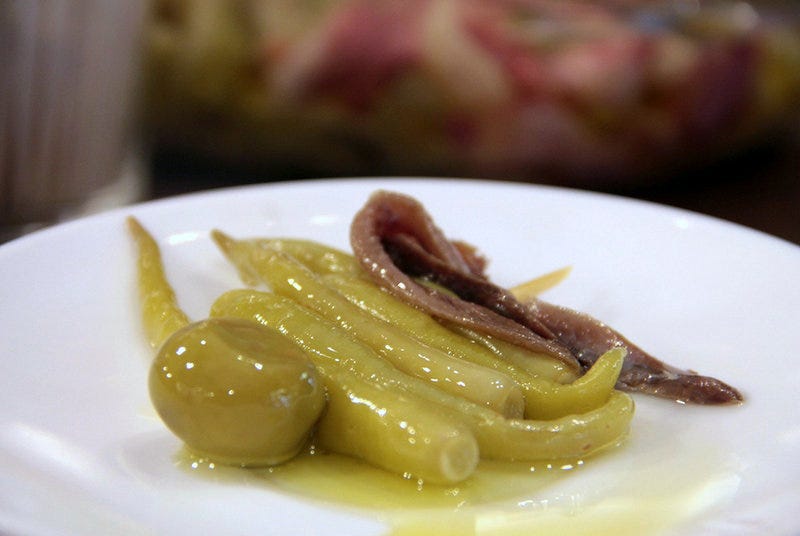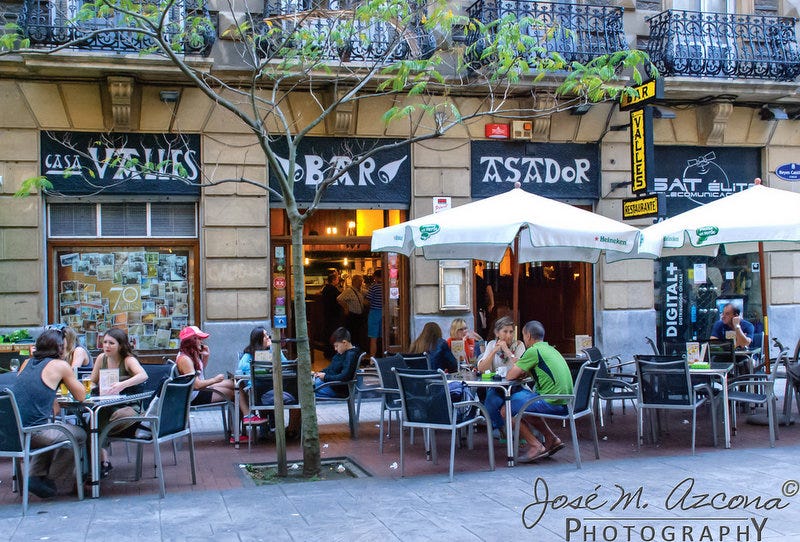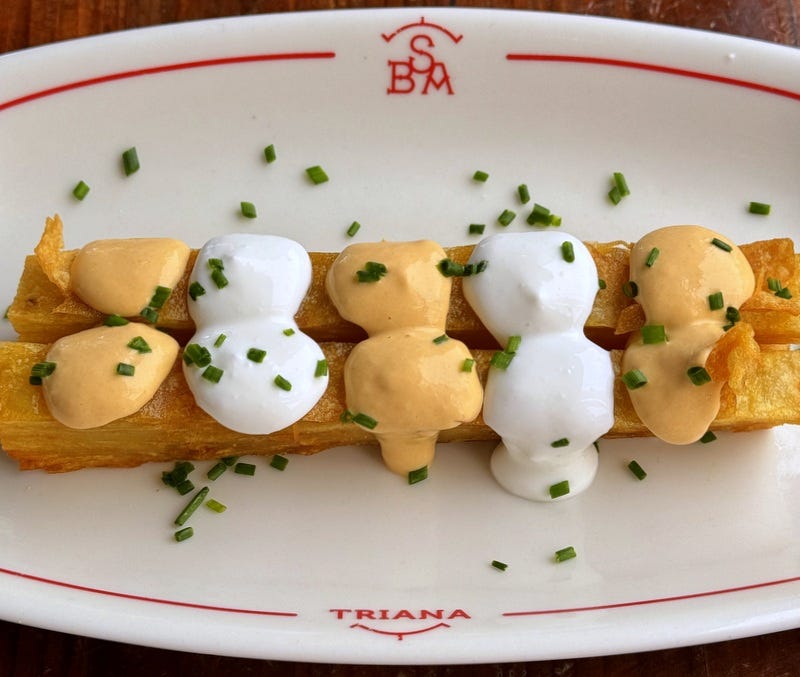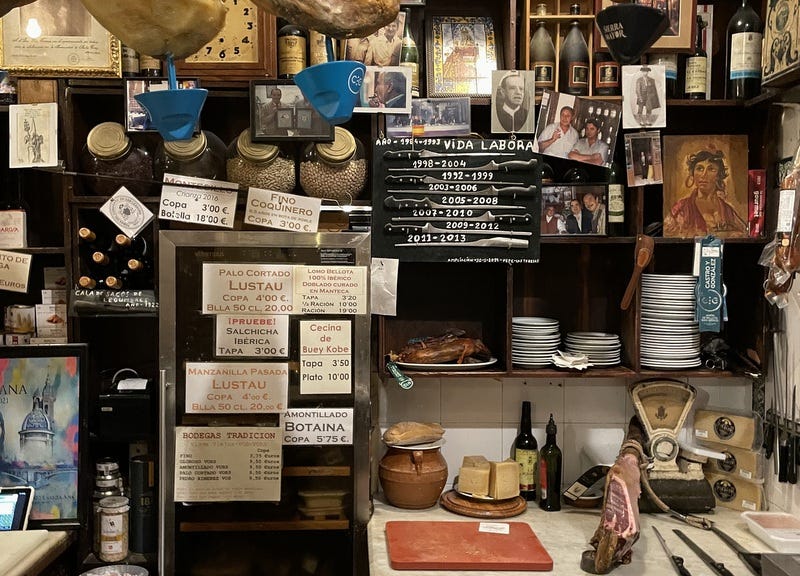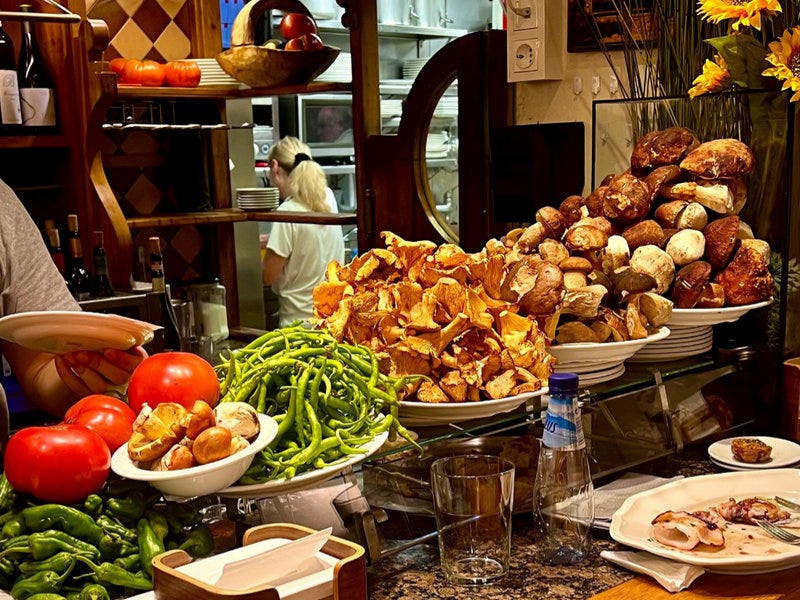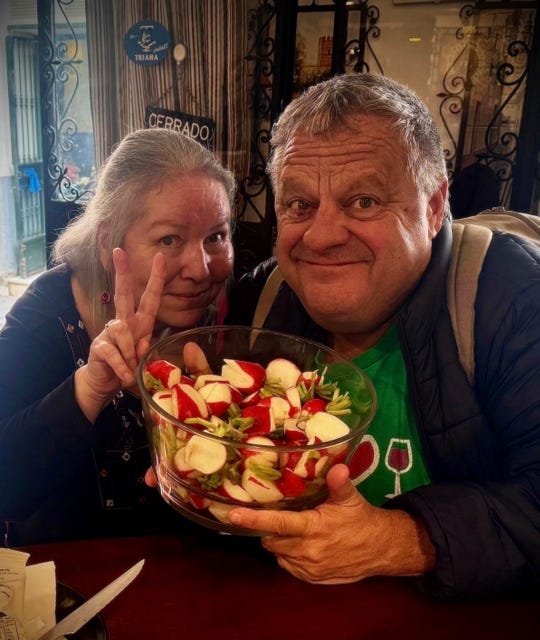Tapas vs Pintxos
The Queen of Tapas teams up With XtremeFoodies
Introduction to your Tapas vs Pintxos hosts:
Shawn Hennessey, representing Bitesize Sevilla and Team Tapas.
Jeffrey Merrihue, representing XtremeFoodies and Team Pintxos.
What is a Tapa?
The definition of a tapa in the RAE (Real Academia Española) Dictionary, 1970 edition: a small portion of a food that is served as an accompaniment to a drink.
In the 1939 and 1956 editions the word tapa appears as an Andalusianism and refers to "cold cuts or ham that are served in albacerías on top of beer or wine glasses as a tapa (lid)". However, gastronomy photographer Manolo Manosalbas, who captured this quintessential tapas image - a slice of something (jamón, cheese, or in this case, mojama) served atop a wine glass - insists that this has never actually happened in any bar anywhere.
In Sevilla tapas were first known as a small aperitif-style snack to be eaten standing at the bar, and were usually just a couple spoonfuls or bites of food served in a small shallow bowl (known as the concha). Tapas culture as we know it today would take many years to develop, as we'll find out later. Meanwhile, I like my friend Reyes Morales' definition, which is: “It’s an aperitivo of just the right size that allows you to ask for another one”.
What is a Pintxo?
The definition of a Pintxo in the RAE (Real Academía Española) Dictionary: A small snack which is often served with a toothpick to be had as an appetizer.
“Pintxos are specifically designed to be small and bite-sized. They are typically served on bread and held together with a cocktail stick. There is no larger size of a Pintxo. If you want more of the dish you need to order multiples.” Pintxos are also combinations of items skewered together on a toothpick or harpooned into a piece of bread. It is often, today, that foodies eat the Pintxo and leave the bread.
The First Tapa?
The precise when and where of the origin of the tapa, is shrouded in history and, in any case, was unlikely to have been the result of any one moment in time or place. Which is to say... nobody knows. And because nobody knows colourful legends abound, including many "king walks into a bar" tales, which are fun and harmless in the “never let the truth get in the way of a good story” vein.
The president of the Academia Sevillana de Gastronomía y Turismo, Julio Moreno Ventas, who has written extensively on this topic, argues that...
The only written document in which "chatos con tapaera" is mentioned for the first time is a chronicle by Nicolás Rivero Muñiz, politician and journalist, who in 1903 attended a lunch at the famous Venta de Eritaña. The other versions are just that...legends.” ~ Julio Moreno Ventas
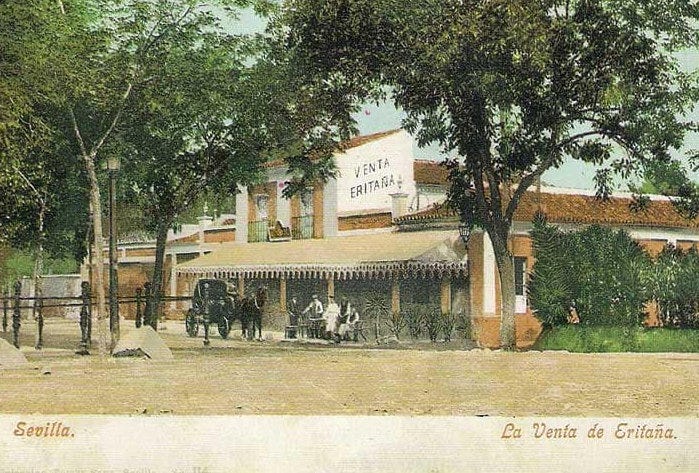
According to Spanish food historian Rosa Tovar (and I agree)...
It is an impossible question to answer. Today there is an effort to ensure that the day and year and place, etc. have been found for when this or that was served for the first time, but they are not very credible.” ~ Rosa Tovar”
None of this means that tapas hadn't been previously happening all around Sevilla and Andalucía before this, just that it hadn't been documented until 1903, and when it was… well it happened in Sevilla.
The First Pintxo?
I totally respect Shawn’s commitment to facts over fiction and for that reason I will not even mention the ridiculous story that their first tapa might have been ham on bread invented by Fernando the VII in 1780 with his fantastically named pal “Brother Manzanilla” at the legendary Ventorillo del Chato near Cadiz. Nope. Not a word about it.
[Shawn: See? King walks into a bar story…]
Now Pintxos is a different story. We ARE allowed to talk about that one because there is all kinds of accepted folklore and credible legend around this fantastic Pintxo.
Legend has it that the original Pintxo was invented at Casa Valles 1942 in San Sebastián.
The elements: pickled hot Guindilla peppers, oil-cured anchovies and Manzanilla olives were all right there, sitting on the bar one day when a regular bar patron and wine salesman: Joaquín Aramburu stuck the three items together on a toothpick and history was made.
At the time, Rita Hayworth, was the star of the movie “Gilda” which was a wildly popular movie in so Joaquin named his creation the Gilda. He said that like the character in the movie, this Pintxo was salty, green, and spicy. The movie went on to claim cult status as did the first immortalized pintxo – the Gilda.
What then - Jeffrey & Shawn - is the difference between Tapas and Pintxos???
Tapas and Pintxo Cultures share many of the same characteristics and in some ways the differences are blurring and disappearing. So here we will together lay out some of the historical differences that used to distinguish the two traditions.
They are both very casual and social ways of eating, often a moveable feast of going from bar to bar on a never ending voyage of discovery and deliciousness that is distinctive to Spain.
You can find similar examples of "small food" elsewhere around the world - canapés, hors d'oeuvres, appetizers, finger foods, mezze and snacks etc - but somehow they do not exist on their own in the same way as a Tapeo (tapas) or Txikiteo (pintxo) bar hopping experience.
Here is how it used to be:
Once upon a time Tapas were served as a complimentary snack with a drink (still true in some parts of Spain) while Pintxos have never been free
Tapas could be either bites of charcuterie or cheese, a few olives, or a small portion of a stew, while Pintxos were often tiny combinations on a toothpick or stabbed onto a slice of bread.
These days...
Pintxos have maintained their original size and, for the most part, ingredients, whereas Tapas now come in many sizes and shapes and can include almost any ingredient you can imagine.
Tapas can become an entire meal - you usually wouldn’t consume Pintxos as a complete meal.
Tapas are consumed either sitting or standing while Pintxos are almost always eaten standing up at the bar.
Tapas have evolved into all kinds of formats. For whatever reason Pintxos has maintained its original snack - pre dinner format.
The Evolution of Tapas
Tapas began as a small aperitif-style snack to enjoy before going home for lunch or out to dinner, but it has since evolved from a simple bite to an entire way of life. The Tapeo, moving from bar to bar, is now a part of the Sevillano DNA, deeply rooted and valued. Meanwhile the dishes themselves have also evolved. From a humble slice of jamón or cheese to a cazuela of spinach with garbanzos or a small plate of fried salt cod, we now have some bars serving what could be considered entrées in some restaurants as tapas. And with prices to match.
For me this is not the essence of what a tapa is and, while I'm certainly not against innovation in gastronomy, I think if you start calling anything that isn't a large plate of food a tapa then the term becomes meaningless.
The Evolution of Pintxos
Here Shawn and I totally agree the “modern” differences become clearer as pintxos are basically still pintxos. They maintain their original essence. Whereas these days a tapa can be almost anything. Personally, I like the original purer formats - but so be it..I also love foie gras and the running of the bulls in Pamplona!
[Shawn: this is true but many pintxo bars now also serve tapas, so they are adopting a southern style of small plates to complement the pintxo.]
Three Tapas you must know about in Sevilla (among many others):
Solomillo al Whisky – probably the only tapa that can be traced back time & place to one small bar in Sevilla in the early 70s. A grilled slice of pork tenderloin served in a garlicky sauce with a citrus punch... but hey no whisky! That's a whole other story I'll tell at another time.
Espinacas con Garbanzos – garlic, cumin, garbanzos and the occasional guidilla come together to unite the region with its moorish past.
Pavía de Bacalao – crispy battered tender bacalao which brings together the Spanish obsession with salt cod (shared with the Portuguese) with the unsurpassed Andalusian skill for frying fish.
Three Pintxos you must know about in San Sebastian
Gilda - The original Pintxo is literally in every bar in San Sebastian and it is always good as it is simply a perfect combination of ingredients:
Pintxo Stack - For example: slice of black pudding (Morcilla), with a slice of goat cheese and a slice of steamed potato topped with a sunny side up quail egg harpooned with a toothpick onto a slice of bread. This, or some version of this, is a “Pintxo stack” where you can get a multi-sensory bite, with layers of flavor in a single, mini-creation. There are 100’s of these kinds of creations in and around San Sebastian and they are what makes Pintxos so exciting
Kokotxas Pil Pil - Cod or hake throats are a cornerstone of Basque gastronomy. These beauties are often grilled over a fire and sauced with a luscious olive oil and garlic emulsion.
Three favorite Tapas Bars in Sevilla
I preface this once again by insisting that just as it’s impossible for me to choose my favorite tapas bar, it is impossible for me to choose my favorite tapa. I once asked a chef to tell me which was his favourite tapa and he said “it's like asking me which is my favorite child!”. But these are three places where I feel especially at home.
Casa Morales - founded in 1850 and still run by the Morales family, now into its fourth generation. When I want comfort and comfort food, this is where I come, usually early to beat the crowds. For me Casa Morales is where time stands still and where I truly feel at home.
Bar Las Teresas – this one is a tough call because it's in the centre of Barrio Santa Cruz and as such is now inundated by tourists, but when I can score a bar stool in front of the jamón cutting station then I am in my happy place and nothing else matters.
Taberna Zurbarán – a newcomer, opened in 2023 and run by the same family that is also partners with our Michelin starred seafood restaurant Cañabota. The concept is traditional tapas with traditional recipes but a bit “elevated” in terms of quality and presentation. Lovely welcoming spot and great terrace full of orange trees.
Three favourite Pintxo Bars in San Sebastián
Bar Sport - Why do I love this place? Maybe because it has delicious Pintxos? Maybe because it is cozy? Nope - I love this place because it is open for breakfast. Everyone talks about the last supper but if I ever have a last breakfast - please lord let it be here 🙏🏻
Bar Antonio - All kinds of arguments rage about the tortilla with or without onions - runny or well set? None of these arguments matter as Bar Antonio destroys these arguments with a freshly made, well set tortilla with onions and peppers that is simply better than every other tortilla you have ever had. This tortilla is made at 9:30am every day and is gone by 11. Stunning.
Ganbara - Is this the greatest Pintxo bar in San Sebastian - and therefore - in the world? Yes. Anthony Bourdain was swept away and so shall you be as well. The mountain of Pintxos on the bar top will cause your body to tingle.
Epilogue from Shawn and Jeffrey
We have thought long and hard about which are better - Tapas or Pintxos? We decided that the winner is - drum roll please - You! There are plenty of small plates around the world but the Tapas from Sevilla and the Pintxos from San Sebastian are unique in the world.
My favorite Tapa or Pintxo of all time?
Shawn: Can I have an easier question please?
Jeffrey: I vote for the radishes on Shawn’s Tapas tour
I have dropped the ULTIMATE XtremeFoodies, San Sebastian, Pintxo walking tour behind this paywall - It includes culture and nature breaks to digest as you eat your way around Pintxo paradise and, just when you think you cannot eat any more - ends with a Pintxo gourmet feast before you drop into a food coma at 23:00 pm.
Keep reading with a 7-day free trial
Subscribe to Xtreme Foodies to keep reading this post and get 7 days of free access to the full post archives.


